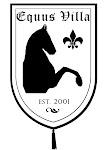I kind of put the cart before the horse as I have already posted this video on Facebook as well as the Sidesaddle group on Facebook.
Here though, I thought I would discuss doing the slow gait and rack aside verses astride.
Let me start by saying that all American Saddlebreds are not gaited, and for good reason. While I believe you could teach any horse or mule the extra gaits, certain bloodlines in this breed have a natural tendency to 'amble' therefore making them better canidates for this. The basic description of the slow gait and rack are best described as written on the ASHA web site:
The footfalls of the slow gait and rack begin with the lateral front and hind feet starting almost together, but the hind foot contacts the ground slightly before its lateral forefoot. The slow gait is a highly-collected gait with each of the four feet striking the ground separately. It is executed slowly but with distinct precision, full of style and brilliant restraint. In the rack, each foot meets the ground at equal, separate intervals. It gives a smooth ride while the horse performs in a slightly uninhibited manner, with great animation, speed and correct form.
My first show horse, Blondie was a mare so proficient at racking, she could not only do it for great lengths of time, but preferred it over the trot. We did everything from showing to trail riding and we actually won a Fast Racking class when she was 20 years old, shortly before her untimely death. She does not look 20 years old does she!
Anyway - the only reason I interjected this was to let you know I am not a stranger to these gaits. It was apparent early on that Sport was a horse that could easily be gaited, so that is the direction we went with him. Every week I could see quite a bit of progress and then one day it was as if a light went on and he was flying around the ring with Sandy. "By golly," I said gleefully, " I think he's got it!"
When you rack astride, you widen your hands getting the reins off the horses neck and tickle the bit, jiggleing it ever so slightly back and forth in the horses mouth. You scoot to the back of your saddle and down onto the 'pockets' of your bottom. You really sit deep on the horse. Blondie needed no encouragment, but with a young horse like Sport, you need to feather your legs on his sides, just as you tickle the bit. It is easy for them to break into the canter when going around a bend (or if they are pushed too hard) as the uneven strides they must make to bend and stay in gait feels different.
The issues I had with Sport were that unlike Blondie, Sport needs all the queues. I was lacking a right leg to feather him with and when I would engage the cane as my false leg, I would sometimes get out of rythem of the bit jiggle! Then riding aside, as we all know has its own challenges for the rider to stay completely centered on the horses back. With the side to side movment I experienced, I had to pay close attention that my body was not getting out of position and off center. In wanting to lean to the right to keep my correct position, I started to wing out my left elbow giving the unsightly appearance of a chicken wing! Ugggghh . Next, I had to make sure I kept my left leg out of his side.
As Sport was learning - so was I. I ignorantly thought it was going to be easy since this is a less bouncy gait than the trot and since I had quite a bit of previous experience.... but I learned quickly that this was a brand new challenge for me.
IF I get good saddle position and good rein position and keep it, all is well. There is not compensating something else if one thing falls apart. It is an all or nothing kind of situation.
As for the bridle, since I use a Weymouth bridle equipt with 2 bits and 4 reins, there is considerable adjustments for each gait. At the trot, it is 75% snaffle and 25% curb. At the slow gait and rack it is 75% curb and 25% snaffle... and if he can wrangle the curb bit away from me at the rack, all is lost.
Sport is very good about the cane. Early on in his training Sandy made it clear that the whip was a device of encouragment, so he never soured away from it. Switching over to the cane was a non-issue for Sport.
One of the ladies at our barn said it best when she said I could not have named him any better... because he is just such a good Sport about it all. He just loves to please and works so hard to get it right .... and looks forward to.. (ahem.. or should I say expects and diserves) his handfuls of carrots and peppermints after each ride!




2 comments:
What a great photo - she looks so well for 20!
Thanks for the informative post :)
He is fantastic!!! Oh, how I'd love to SOME DAY have a five gaited saddlebred. I actually decided this a long time ago as a Jr. Exhibitor. A lot of the shows I attended with my Morgan were shared with the Saddlebreds. I remember waiting anxiously for the 5-gaited classes and just loving every second of it when they swept into the ring in a flurry! How cool for you and Sport :)
Post a Comment